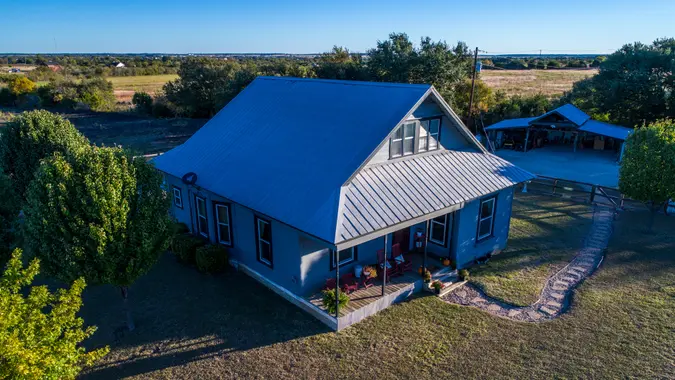How To Successfully Make A Low Offer On A House

Commitment to Our Readers
GOBankingRates' editorial team is committed to bringing you unbiased reviews and information. We use data-driven methodologies to evaluate financial products and services - our reviews and ratings are not influenced by advertisers. You can read more about our editorial guidelines and our products and services review methodology.

20 Years
Helping You Live Richer

Reviewed
by Experts

Trusted by
Millions of Readers
Ever since their low during the coronavirus pandemic, housing prices have been on a tear, in some cases more than doubling in just a few years. Add in some of the highest mortgage rates in decades and homes now sit at near-record levels of unaffordability.
That’s not exactly the kind of environment where buyers have the leverage to demand bargain-basement prices. However, those with a strategy and an eye for opportunity can always find sellers who are willing to go low.
But that doesn’t mean you can just make an offer of 20% off the asking price and expect success, according to Lucas Machado, president of House Heroes LLC.
“At the end of the day, the homebuyer and home seller need to settle on price and terms that work for everyone involved,” said Machado. “If that’s achieved, all parties walk away happy. If that isn’t achieved, no home sale will ever occur.”
If you’re considering making a lowball offer for a property, check out these things to know first.
What Is a Lowball Offer?
A lowball offer is one that comes in significantly below the seller’s asking price. For example, if a home is listed on the market at $400,000, a bid of $325,000 would certainly be considered a lowball offer.
Common Misconceptions
A lowball offer isn’t just any offer below the asking price. True lowball offers typically come in at least 20% below a listing’s asking price.
Why Buyers Consider Making Lowball Offers
Potential for Savings
The main reason to make a lowball offer is to snag a good property at a below-market price. There’s a saying in real estate that your profit is made when you buy the home, not when you sell it; this is meant to emphasize that a good entry price significantly boosts your chance for profits down the road.
Testing Seller Motivation
A lowball offer is also a good way to take the temperature of an individual seller or even of the market overall. In a softening market, sellers are more willing to make accommodations for buyers. If one entertains your lowball offer, even if they don’t immediately accept it, that can be an indication of a market in which you have more leverage in your negotiations.
Risks Associated with Lowball Offers
Offending the Seller
If your offer is too low, you might offend the seller and reject the offer outright. It can also paint you as a buyer who is not willing to pay full price or even make a near-market order. Even if you make another offer at a higher price, a seller might dismiss you as a buyer who is not serious.
Losing the Property to Other Buyers
If you make a lowball offer and other buyers are willing to pay a higher price, you’re going to lose out on your chance to own that property. If you really love a property and aren’t willing to watch it go to somebody else, you might want to avoid making a lowball offer.
Factors To Consider Before Making a Lowball Offer
Current Market Conditions
In some markets, lowball offers get accepted all the time. On others, lowball offers are likely to get immediately dismissed. It’s important to determine if you’re in a buyer’s or a seller’s market before you make your offer.
Property’s Time on the Market
The longer a property has been on the market, the more likely you are to succeed if you make a lowball offer. Homes listed for extended periods may have more flexible sellers.
Comparable Home Prices
You don’t want to make an offer that’s so low that it’s considered frivolous. Research the recent sales prices of similar homes in the area to get a feel for what’s selling and what’s not. Use that information to help you determine just how low of an offer you can successfully make.
How To Make a Lowball Offer Successfully
Conduct Thorough Research
If you want to give your lowball offer a real chance at success, you should gather as much information as possible on the property’s value and market trends. If you simply post an offer that’s 25% below a property’s listing price, hoping the seller will bite, you won’t generally succeed very often. But if your research shows you that a home has been on the market for a long period of time and it keeps getting relisted at lower prices, you may have a shot. This is particularly true if the market overall in your area is particularly soft.
Present a Justified Offer
If you are going to make a low-ball offer, you’d better be ready to back up your reasoning with facts, according to Merrill. Is the market cold? Has the home been on the market for more than 30 days? Are there inherent damages to the home? These are all good things to point out if true, said Merrill.
“It is worth it to spend a little extra money on a highly seasoned inspector,” according to Than Merrill, host of A&E’s “Flip This House” and CEO and co-founder of the real estate investment education company FortuneBuilders. Merrill said. “A professional inspector will scrutinize every corner of the home until he or she finds a problem that might help to justify a low-ball offer. If you’re able to uncover something the seller may have been trying to hide, they won’t have any choice other than to take your offer.”
In other words, if you want your offer to receive serious consideration, provide reasons and evidence supporting your lower offer.
Maintain Respectful Communication
Approach negotiations professionally to keep discussions open. This is especially important if you’re making a lowball offer that could otherwise be seen as not serious.
How Low Can You Offer on a House?
Determining an Appropriate Offer Percentage
Generally, offers of about 20% to 25% below the asking price may be considered lowball. However, this can vary based on local, regional and national market conditions. In some cases, offers of just 10% below the listing price might qualify as lowball, particularly in hot markets.
Balancing Savings with Seller Expectations
The idea behind putting in a lowball offer is that you can get a good property at a reduced price. But sellers, acting in their self-interest, want they best deal for themselves also. Since your price is by definition not the one the seller is looking for, you should work to ensure that your offers is attractive enough to be considered. For example, you may want to offer flexibility with the closing date, waive requests for repairs or even make a cash offer to stand out to the seller.
Can You Offer Less on a House?
Evaluating the Seller’s Pricing Strategy
If you understand the market, including a home’s listing history, you might be able to tell if a seller is just fishing for a higher price and might be willing to accept a lower offer. If a listing is posted well above current market valuations in the local area, for example, it may be an opportunity to make a successful lowball offer.
Timing Your Offer
There are certain times when sellers may be more willing to negotiate a sale than others. For example, if you’re looking at a home in a seasonal area, the low season could be a good time to come in with a lowball offer. Distressed or motivated sellers, such as those who inherited a home after a death in the family or those with other pressing needs to sell, might be more open to negotiation.
What Is Considered a Lowball Offer on a House?
Percentage Below Asking Price
What qualifies as a lowball offer is in the eye of the beholder. But generally speaking, offers between 20% and 25% below the list price are often viewed as lowball. However, this can change, according to local market conditions.
Market Perception
In a crashing or rapidly falling housing market, you should expect to see lowball offers on a large number of homes. This is true even if the national housing market trend is up. More than nearly any other type of asset, real estate is extremely local in nature when it comes to pricing.
More From GOBankingRates
 Written by
Written by  Edited by
Edited by 

























